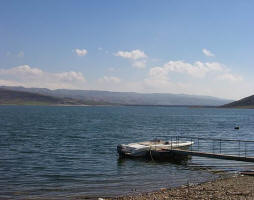- Regional water observation mechanism
- Regional Cooperation Assessment
- Water Quality Monitoring (JP)
- Water scarcity and drought (JP)
- Groundwater (JP)
- Waste water reuse (JP)
- Shared Water Resources Management (JP)
- Linking rural development and water management (JP)
- Waste management
- Water institutions
- Climate Change
- Floods
- Desalination
- Right to Water
- Irrigation
- Satellite data
- Water reports & data
- Hydrology
- Sanitation
- Gender and IWRM
- ArabWAYS
- Non-Revenue Water
- Virtual Water & Water Footprint
- WANA Water Panel
- Water Demand
- Water Governance
- Water Pricing
- Water accounts
- Water nexus Energy
- Geosciences
- Rural Management
 Transboundary River Basin management Regimes: The Tisza Basin Case Study
Transboundary River Basin management Regimes: The Tisza Basin Case Study
Background report to Deliverable 1.3.1, Status: Final, Author: Gert Becker, Date: 18. 6. 2005.
The Tisza river basin (TRB) originates in the Carpathian Mountains in the territories
of Romania, Slovakia and Ukraine and is the largest catchments area (157 218 km2)
among the 15 sub-basins of the Danube Basin (801 463 km2).
The Tisza flows (average discharge of 794 m3/sec) through the Pannonian flood plain
of eastern Hungary and joins in Serbia-Montenegro the Danube.
The river can be divided into 3 main parts:
- the mountainous Upper Tisza in the Ukraine (including the tributaries of
Romania)
- the Middle Tisza in Hungary, receiving the tributaries Bodrog and Sajo from
the Carpathian mountains in Slovakia and Ukraine and the Szamos, Koros and
Maros draining Transylvania in Romania
- the lower Tisza downstream of the Hungarian-Serbian border, where it
receives the Begej and small tributaries through the Danube-Tisza Canal
system and joints the Danube between Novi Sad and Belgrade.
The mean discharge at the confluence with the Danube is 766 m3/s, ranging from
a low 371 m3/s to a 1% peak discharge of 3867 m3/s (Schnellmann 2002, ICPDR
2004).
| Creator | n/a |
|---|---|
| Type of document | Report |
| Rights | Public |
| File link | n/a |
| File link local |
|
| Source of information | NEWATER project |
| Keyword(s) | Transboundary River Basin management |
| Subject(s) | POLICY-WATER POLICY AND WATER MANAGEMENT |
| Geographical coverage | Germany, Netherlands, United Kingdom, France, Denmark, Austria, Uzbekistan, Belgium, Italy, Czech Republic, South Africa, Portugal, Switzerland, Ukraine, Spain, Sweden |
 you are not logged in
you are not logged in





